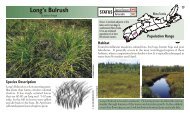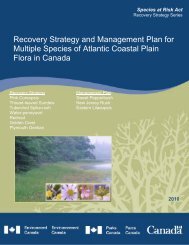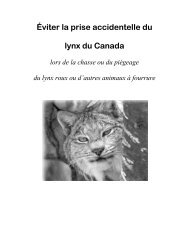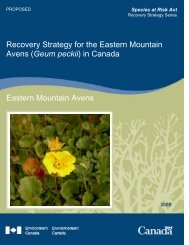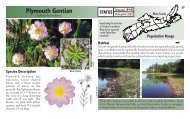Healthy Lakes and Wetlands For Tomorrow - Species at Risk
Healthy Lakes and Wetlands For Tomorrow - Species at Risk
Healthy Lakes and Wetlands For Tomorrow - Species at Risk
Create successful ePaper yourself
Turn your PDF publications into a flip-book with our unique Google optimized e-Paper software.
THINKING AHEAD<br />
M. Crowley<br />
M. Crowley<br />
TRACKING YOUR PROGRESS<br />
We hope th<strong>at</strong> you have found the inform<strong>at</strong>ion in this guide useful <strong>and</strong> th<strong>at</strong> you take the time<br />
to observe the life around you <strong>and</strong> see how an increase in wildlife habit<strong>at</strong> will reward you with<br />
many n<strong>at</strong>ural wonders. Take pictures of your property over time to record the beneficial changes<br />
you are making to your l<strong>and</strong>. Get the whole family involved, learn the names of the animals <strong>and</strong><br />
plants th<strong>at</strong> share your property with you <strong>and</strong> record the species you notice. See if you observe a<br />
gre<strong>at</strong>er diversity of n<strong>at</strong>ive birds, snakes, turtles, butterflies, frogs, wildflowers, shrubs <strong>and</strong> plants.<br />
Remember to share wh<strong>at</strong> you learn <strong>and</strong> see with your friends, family, <strong>and</strong> neighbours.<br />
PLANNING FOR THE FUTURE: WORKING WITH YOUR LAND<br />
People like to build along lake shorelines because they are<br />
<strong>at</strong>tracted to the n<strong>at</strong>ural beauty <strong>and</strong> wonder of the area. If we<br />
can maintain the n<strong>at</strong>ural l<strong>and</strong>scape from the start of the building<br />
process, we can elimin<strong>at</strong>e years of effort trying to revert the<br />
transformed l<strong>and</strong>scape back to its n<strong>at</strong>ural beauty.<br />
If you are building or renov<strong>at</strong>ing your house or cottage try to:<br />
Build the structure into the l<strong>and</strong> <strong>and</strong> existing fe<strong>at</strong>ures r<strong>at</strong>her than trying to make the l<strong>and</strong><br />
•<br />
conform to the structure.<br />
• Build your road or make sure the developer keeps the road well back from the w<strong>at</strong>er body<br />
to ensure th<strong>at</strong> you can build <strong>at</strong> least 30 m (100 feet) from the w<strong>at</strong>er.<br />
• Leave existing trees, rocks, <strong>and</strong> other n<strong>at</strong>ural fe<strong>at</strong>ures to keep unique l<strong>and</strong>marks on the<br />
property, increase visual diversity, <strong>and</strong> to help maintain n<strong>at</strong>ural biodiversity. This also<br />
reduces the amount of exposed soils (a rare event in n<strong>at</strong>ural ecosystems), which reduces<br />
the chance of introducing invasive alien plants.<br />
Modify the l<strong>and</strong> in phased intervals over a period of years r<strong>at</strong>her than all <strong>at</strong> once to give<br />
•<br />
the l<strong>and</strong> time to heal <strong>and</strong> recover.<br />
By keeping the surrounding habit<strong>at</strong> as n<strong>at</strong>ural as possible you will have the maximum opportunity<br />
to enjoy <strong>and</strong> relax <strong>and</strong> will minimize your footprint on wildlife <strong>and</strong> species <strong>at</strong> risk.<br />
48




